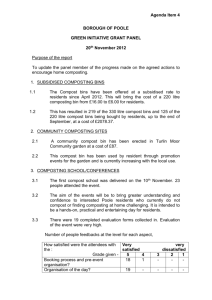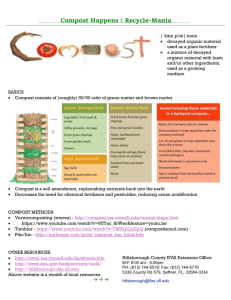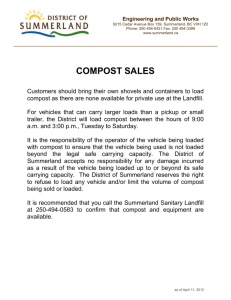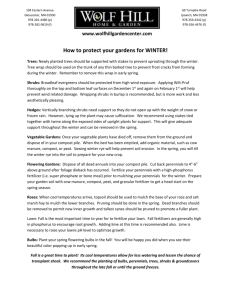Report
advertisement
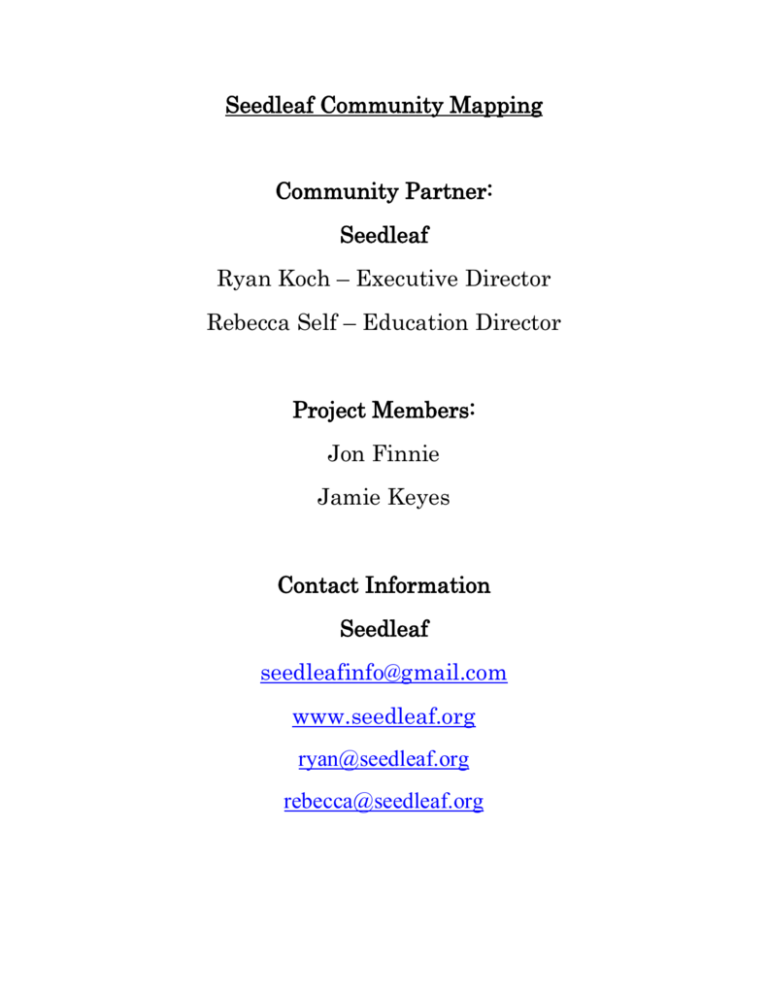
Seedleaf Community Mapping Community Partner: Seedleaf Ryan Koch – Executive Director Rebecca Self – Education Director Project Members: Jon Finnie Jamie Keyes Contact Information Seedleaf seedleafinfo@gmail.com www.seedleaf.org ryan@seedleaf.org rebecca@seedleaf.org Table of Contents Project Summary Needs Assessment Report Progress Report Data Dictionary Products Conclusion Project Summary The objective of this project was to provide Seedleaf with information products that will assist in two ways, both internally and externally. To provide information to external parties that are interested in Seedleaf, several maps were created. Utilizing the website BatchGeo, an embeddable map was created that Seedleaf can utilize on their website so that people can easily find public Seedleaf resources, such as community gardens and compost bins. BatchGeo was chosen because it is simple to use and easy to maintain, this makes it possible for Seedleaf to update information on the map with little to no hassle. To provide for Seedleaf’s internal needs, a series of locative maps were made using ArcMap 10. Each map located certain assets of Seedleaf, e.g. a map of their Seedleaf Farms Also, as a means to utilize geospatial technology to improve Seedleaf’s planning, a map displaying the percent change in people living below the poverty level was created. Needs Assessment Report I. Project background information Seedleaf is an organization whose primary activity is “nourishing communities by growing, cooking, sharing, and recycling food so that we can increase the amount, affordability, nutritional value, and sustainability of food available to people at risk of hunger in central Kentucky” (seedleaf.org). Seedleaf is responsible for eight community gardens, eight half-acre Seedleaf Farms which produce food for local markets and restaurants, and 25 drop-off sites for compost in Lexington, Kentucky. They also utilize various spaces around downtown Lexington for workshops and activities that conform to the organization’s mission. II. Goal and objectives Our group will collaborate with Seedleaf to produce maps and information products that will assist Seedleaf in two primary ways: (1) to inform the public of Seedleaf’s assets and (2) to inform Seedleaf’s internal operations in the way of planning and strategizing their programming. To meet Goal 1, we will create a map(s) for the organization’s website that will locate gardens and compost bins. To meet Goal 2, we will map demographic data that will identify the areas which will be best served by Seedleaf. This map will be created using ArcMap 10 and will be presented to Seedleaf for their internal operations. III. Data acquisition and preparation steps The data needed are as follows. The use of italics indicates tentative need. Data Type One: Site-Based Data For map of Seedleaf’s programming I. Addresses community gardens Seedleaf farms Composting sites (bins, where compost is processed) Compost pickup sites II. Site-based attributes Community gardens o o categories of food grown at each location open gardening hours (hours of operation) o o yield totals Volunteer data: Avg number of volunteers at each location Volunteer demographics Volunteering at site via organization (are they volunteering there as a function of involvement in a service organization, church, student group, or simply by their own individual volition?) Age geographic origin: are they volunteers from the neighborhood or from a non-contiguous area? Seedleaf Farms o o o Categories of food grown End location of food: where or to whom is food sold? Yield totals? Composting o o composting totals – weight or volume (in gallons) of compost processed breakdown of composting volume by location? Post composting: where does compost go? this just shows link between composting & gardening programming Data Type Two: Demographic Analysis Data For strategic/planning map. Data would be collected for Seedleaf’s region of operation Possible areas of expansion I. Census Data Population Density Race Mean or average age Mean or average income 2. Non-Census Sourced Demographic Data K-12 free and reduced lunches Rates of diet-related illness and disease Steps for maps of Seedleaf assets and programming: 1. 2. 3. 4. 5. compile addresses of Seedleaf assets and programming in Excel files geocode these addresses to create a shapefile build an attractive basemap create symbology and labels make sure attribute tables contain all data and metadata we’ve collected Steps for Demographics maps: 1. using Census sources and email correspondence, collect aforementioned demographics data 2. Format data in Excel as needed 3. Find out where stores that sell fresh produce are located. Also ask Seedleaf for a list of corner stores that have committed to or expressed interest to selling produce. IV. List of maps and analyses demographic analyses map – created in ArcMap map of Seedleaf assets: gardens, farms, compost operations – created in ArcMap online application mapping gardening activities and volunteer opportunities – using Google Maps V. Steps required for demographic analysis map: 1. 2. 3. 4. 5. 6. 7. compile demographic data in Excel spreadsheets geocode these data to create a shapefile build an attractive basemap spatial join basemap to shapefile create symbology and labels confirm that attribute tables contain all data and metadata we’ve collected present map and accompanying Excel spreadsheet to Seedleaf for assets and programming map (Google maps): 1. 2. 3. 4. compile address data in Excel spreadsheets chart these addresses on Google Maps add photographic data to features on Google Maps use soon-to-be-identified application to embed map on Seedleaf’s website for assets and programming map (ArcMap) 1. 2. 3. 4. compile address data in Excel spreadsheets geocode these address data to create a shapefile spatial join pre-made basemap to shapefile create symbology and labels, differentiating among different categories of programming and assets 5. confirm that attribute tables contain all data and metadata we’ve collected 6. present map and accompanying Excel spreadsheet to Seedleaf Progress Report I. Tasks Completed: a. Created a master spreadsheat that contains the locations of Seedleaf assets b. Geocoded all of Seedleafs Assets locations c. Created several maps depicting Seedleaf assets and a poverty level map. II. Questions and/or Problems to be resolved. a. Is it possible to find actual 2010 census income data, not just estimates b. Is it possible to obtain all data that Brad Gosser obtained about school free and reduced lunches III. Summary of mid-project meeting. a. Met with Ryan at Coffea, discussed details about mapping project. IV. Any changes to project goals? a. Due to absence of Brad and the data that he obtained and time constraints, was not possible to do any analysis containing school free and reduced lunch data. Decided to use data available from the 2000 census and Federal Financial Institutes Economic Council concerning poverty levels to perform a rudimentary analysis concerning poverty level changes in regards to location of Seedleaf resources. V. Maps a. Created an online Map using BatchGeo that Seedleaf can embed on their webpage, and update data seamlessly, that shows the locations of community gardens and compost bin locations b. Created hard copy maps for community garden locations, market garden locations, compost bins and compost partners. Also created a map showing the % change in poverty levels by census tract for those census tracts that data was available. Data Dictionary 1. 2000_Census_Poverty_Data: Census tract-level data for Fayette County containing poverty data from the 2000 Decennial Census. 2. Batch_Geo_GARDENS.xlsx: an Excel spreadsheet containing the names, location, city, state, zip code, type, image URL, work time, and relevant contact email for each of Seedleaf’s community gardens. 3. Batch_Geo_GARDENS_COMPOST.xlsx: an Excel spreadsheet containing name, location, latitude, longitude, city, state, zip code, type, image URL, work times, and relevant contact email addresses for Seedleaf’s community gardens and compost processing sites. 4. comm_garden_geocode_2012.shp: a shapefile of the geocoded addresses of Seedleaf’s community gardens (companion files include comm_garden_geocode_2012.dbf, comm_garden_geocode_2012.prj, comm_garden_geocode_2012.sbn, comm_garden_geocode_2012.sbx, comm_garden_geocode_2012.shp.xml, and comm_garden_geocode_2012.shx). 5. Comm_Gardens_Geocoding.xls: an Excel spreadsheet with Seedleaf’s community garden addresses formatted for geocoding in ArcMap 6. Comm_Gardens_Locations.xls: an Excel spreadsheet detailing the addresses, urls, contact information, work times, and partner organizations for each Seedleaf garden. 7. comm_gardens_polygon.shp: a shapefile containing polygons of Seedleaf’s community, drawn using the Create Polygon function of ArcMap 10’s Editor Toolbar (companion files include comm_gardens_polygon.dbf, comm_gardens_polygon.prj, comm_gardens_polygon.sbn, comm_gardens_polygon.sbx, comm_gardens_polygon.shp.xml, and comm_gardens_polygon.shx). 8. compost_bins_geocode.xlsx: an Excel workbook derived from compost_processing_sites.xlsx. Sheet 1 features address data for the locations of certain Seedleaf compost bins, Sheet 2 features the latitudinal and longitudinal coordinates for the remaining Seedleaf compost bins. The spreadsheet is structured and formatted to allow for address geocoding from Sheet 1 and XY lat/long geocoding from Sheet 2. 9. compost_partner_geocode_2012.shp: a shapefile containing the geocoded addresses of businesses and nonprofits participating in Seedleaf’s Compost Partners program. Derived from the dataset included in compost_partners_geocode.xlsx. Companion files include compost_partner_geocode_2012.dbf, compost_partner_geocode_2012.prj, compost_partner_geocode_2012.sbn, compost_partner_geocode_2012.sbx, compost_partner_geocode_2012.xml, and compost_partner_geocode_2012.shx. 10. compost_partners_addresses.xlsx: an Excel spreadsheet featuring the addresses of businesses and nonprofits participating in Seedleaf’s Compost Partners program. 11. compost_partners_geocode.xlsx: an Excel spreadsheet featuring the addresses of businesses and nonprofits participating in Seedleaf’s Compost Partners program, formatted for geocoding in ArcMap 12. compost_processing_sites.xlsx: an Excel spreadsheet featuring a comprehensive list of latitudes, longitudes, and addresses of Seedleaf’s compost processing sites. 13. farmcropped.JPG: a cropped JPEG image of Seedleaf’s “Seedleaf Farms” logo. 14. FFIEC_Data_2010.xlsx: an Excel spreadsheet containing 2010 census tract-level poverty data collected by the Federal Financial Institutions Examination Council, downloaded from http://www.ffiec.gov/. 15. market_garden _addresses.xlsx: an Excel spreadsheet containing the addresses of Seedleaf’s Market Gardens (Seedleaf Farms). 16. market_garden_geocode_2012.shp: a shapefile containing the geocoded addresses of Seedleaf’s market gardens (Seedleaf Farms). Derived from market_garden_geocoding_2012. Companion files include market_garden_geocode_2012.dbf, market_garden_geocode_2012.prj, market_garden_geocode_2012.shx, and market_garden_geocode_2012.shp.xml. 17. market_garden_geocoding_2012: an Excel spreadsheet containing the addresses of Seedleaf’s Market Gardens (Seedleaf Farms), formatted for geocoding in ArcMap. 18. Pov_diff_2000_2010.shp: a shapefile visualizing the quantitative analysis of Poverty_changes_2000_2010.xlsx. Companion files include Pov_diff_2000_2010.dbf, Pov_diff_2000_2010.prj, Pov_diff_2000_2010.sbn, Pov_diff_2000_2010.sbx, Pov_diff_2000_2010.shx. 19. Poverty_changes_2000_2010.xlsx: an Excel spreadsheet that draws from data found in FFIEC_Data_2010.xlsx and 2000_Census_Poverty.xlsx to show economic dynamics on a census tract level in Fayette County, Kentucky. 20. Seedleaf logo.jpg: a JPEG image of Seedleaf’s green logo. 21. Seedleaf white logo.jpg: a JPEG image of Seedleaf’s white logo. 22. tl_2010_21067_tract10.zip: Census tract geometries for Fayette County, Kentucky from the 2010 Decennial Census. 23. XYSheet1$.shp: a shapefile containing the geocoded latitudinal and longitudinal coordinates of certain Seedleaf compost bins. This file is derived from the dataset found in compost_bins_geocode.xlsx. Companion files include XYSheet1$.dbf, XYSheet1$.sbn, XYSheet1$.sbx, XYSheet1$.shp, and XYSheet1$.shx. Products BatchGeo Map with community gardens and compost bin locations. http://batchgeo.com/map/8597071cdaeab8d6fe57481812 70cfdf Seedleaf master spreadsheet containing locations of all Seeleaf assets. Seedleaf Farms map Seedleaf Community Garden and Compost Bin map Poverty Change Map Conclusion The maps and data products created will help to improve Seedleaf’s internal and external functions. Even the Excel spreadsheets—which simply list the addresses of Seedleaf’s gardens, Compost Partners, compost bins—represent a major step forward in terms of Seedleaf’s data needs. The analytical map that was created suggests two things: first, it appears that the areas closer to the “East End” have been becoming poorer, whereas the areas nearer Limestone and the NoLi area are becoming more affluent. Since the gardens that have received the most attention—London Ferrill and North Pole—are located in areas of less economic need. In future analyses, it would be beneficial to find income and poverty data on the Census block level so as to analyze these geographic patterns in finer detail (Census block data was not used in this analysis only because 2010 decennial Census income and poverty level data for Fayette County on even the Census Level have not been released). At present, Seedleaf might use these maps to prioritize their programming: since the mission of Seedleaf is to provide services to disadvantaged populations, Seedleaf might use these maps to increase its efforts in the areas of greater need.


